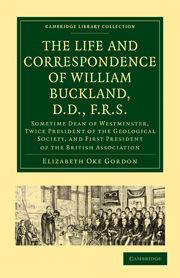 The Life and Correspondence of William Buckland, D.D., F.R.S.
The Life and Correspondence of William Buckland, D.D., F.R.S. CHAPTER VII
Published online by Cambridge University Press: 05 November 2011
Summary
On Christmas Day, 1839, occurred the remarkable landslip at Axmouth, the extent of which, says Buckland, “far exceeds the earthquakes of Calabria, and almost the vast volcanic fissures of the Val del Bove on the flanks of Etna.” Dr. and Mrs. Buckland were both quickly on the spot, and while the Professor made careful investigations into the cause of the catastrophe, his wife, with her clever pencil, made a series of careful drawings of this curious phenomenon, from one of which the illustration on the following page is taken. Buckland at an Ashmoleam meeting thus describes the event:—
“The recent sinking of the land and elevation of the bottom of the sea at Axmouth, Devon, which occurred during two days, December 25 th and 26th, have no analogy to the motions of an earthquake, but come from an entirely different cause. The cliffs on that part of the coast consist of strata of chalk and cherty sandstone, resting on a thick bed of loose sand or fox-mould, beneath which is a series of beds of fine clay impervious to water. Owing to the long continuance of wet weather in the last autumn, the lower region of the fox-mould had become so highly saturated with water as to be reduced to semi-fluid quicksand. The coast from Axmouth to Lyme Regis presents vertical cliffs of chalk about five hundred feet above sea level, between which cliffs and the beach a space, varying from a quarter to half a mile in extent, is occupied by ruinous fallen masses of chalk and sandstone, forming an undercliff similar to that in the south coast of the Isle of Wight. […]
- Type
- Chapter
- Information
- The Life and Correspondence of William Buckland, D.D., F.R.S.Sometime Dean of Westminster, Twice President of the Geological Society, and First President of the British Association, pp. 173 - 191Publisher: Cambridge University PressPrint publication year: 2010First published in: 1894
